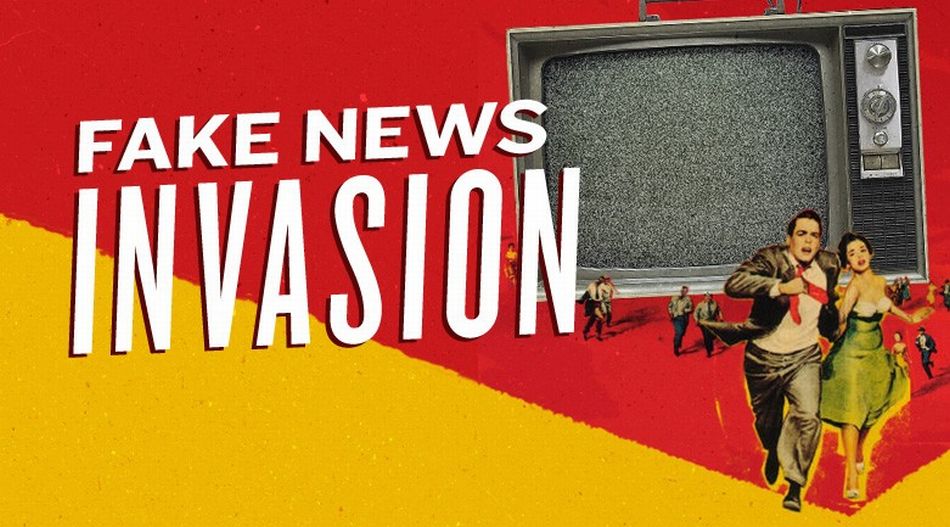By George Martin Fell Brown, Socialist Alternative in the US
Donald Trump’s victory in the 2016 presidential election signifies a war on workers, on women, on immigrants, on LGBTQ people and racial minorities. But for some, it signifies a war on truth itself. The Oxford English Dictionary has gone so far as to name “post-truth” it’s word of the year for 2016. And thanks to Kellyanne Conway, Trump’s campaign strategist, “alternative facts” may be the word of the year for 2017. Trump has become notorious for incoherent stream-of-conscious rants devoid of any connection to reality. And the idea that he could win the election has been blamed on the proliferation of “fake news.”
Much of the talk is about the Russian government’s role in helping to get Trump elected. Vladimir Putin has a history of backing far right forces in Europe and the U.S., including Trump, and propagandizing on their behalf. But this grain of truth has been able to spiral into an echo chamber of conspiracy theories as disreputable as Russian propaganda itself.
The concern over “fake news” has become contentious. Many of the most vociferous voices against fake news have been found to be engaging in it themselves. The Washington Post made a fool of itself when it posted two fake news stories in a span of six weeks about the Russian threat. Even more embarrassing was that one of those fake news stories was about the danger of fake news.
The controversy came full circle when CNN reported on, and the clickbait website Buzzfeed published, a dossier claiming that the Russian government blackmailed Trump with an alleged sex scandal. The claims in the dossier are unsubstantiated, unverified, and sometimes unverifiable, but social media still took the claims as fact. When Trump addressed the issue in a press conference, he refused to answer questions from CNN, dismissing them as “fake news” only to follow it up by answering questions for the far-right propaganda website Breitbart.
The discussion about fake news has focused on how social media creates an echo chamber where disreputable news sources can be taken as fact. This echo chamber has allowed conspiracy theorists like Alex Jones to find a mass audience. It has allowed far-right propaganda outlets like Breitbart to become some people’s primary news source. Entire industries have developed in places like Veles, Macedonia, where teenagers churn out made-up news stories and cheat search engine algorithms in order to cash in on penny-per-click advertising.
But social media has also helped real news to spread, as reports from protests have bypassed the silence of the corporate media, as seen in the use of live streams by the #BlackLivesMatter and #NoDAPL movements to publicize injustice. And the corporate media hardly has a spotless record.
For all the talk about entering a new “post-truth” era, newspapers have printed fake news stories for quite some time. The Hearst and Pulitzer media empires of the 19th century were known for “yellow journalism” which boosted the Spanish-American war in 1898 with false claims that the U.S.S. Maine had been sunk by Spain. The U.S. military buildup in the Vietnam War was precipitated on the similarly fabricated Gulf of Tonkin incident. The Gulf War was fought partly on the basis of fake news stories claiming that the Iraqi military was stealing incubators from Kuwaiti hospitals, leaving babies to die. The second war in Iraq was fought on the basis of phony stories about weapons of mass destruction and links between Saddam Hussein and al-Qaeda. Fake news like this helped lead to hundreds of thousands of deaths but it didn’t come from Macedonian teenagers. The stories about the weapons of mass destruction came from Pulitzer Prize-winning journalist Judith Miller writing exclusive fake news in the New York Times.
In reality, the scare about fake news is less concerned with encouraging critical thinking and more concerned with defending the integrity of the corporate media (“real news”) against any challenge. This is especially clear in the wake of the Washington Post’s blacklist scandal. The Post declared, “Russian propaganda effort helped spread ‘fake news’ during election, experts say”. The “expert” consulted was a website called PropOrNot which, according to the Washington Post, identified “more than 200 websites as routine peddlers of Russian propaganda during the election season”. Unfortunately, it turned out that PropOrNot was itself a fake news site every bit as disreputable as the dreck coming out of the Macedonian news mills.
Rather than an exposé of fake news, PropOrNot’s list was effectively a blacklist of any journalism critical of the Democratic Party. The blacklist was not limited to right-wing sites like the Drudge Report. Left wing alternative news sources like CounterPunch, Truthdig, Truthout, Black Agenda Report, and Naked Capitalism were all deemed to be “fake news” and “pro-Putin propaganda”. Not content with slandering these news sources, PropOrNot publically called for “formal investigations by the US government” against the victims of their slander. You can’t fight fake news by calling on the government to crack down on real news.
This shows how the hysteria about “fake news” and “post-truth politics” has become the hallmark of the ruling class opposition to Trump. Workers and the oppressed are more concerned with Trump’s reactionary political agenda. But the corporate media, the establishment politicians, and U.S. intelligence are more concerned with the blow Trump dealt to their prestige. As such most of the lamentations about fake news are concerned with demonstrating that the corporate media is “the truth”, that establishment politicians are “the truth”, and that U.S. intelligence is “the truth”. And when those representatives of “the truth” lie it can be far more damaging than when Alex Jones spouts out yet another conspiracy theory.
This is clearest in the increasing misuse of fact-checking websites like Politifact. These sites are devoted to scouring through isolated comments by various politicians and looking up whether the comments were true or not. This goes beyond assessing individual facts, to compiling statistical analyses of individual politicians to see what percentage of their statements are lies. Thus we learn that only 15% of Trump’s statements were deemed “True” or “Mostly True” making him 15% honest. But a statistical analysis of hand-picked statements that Politifact’s fact-checkers felt like fact-checking is scientifically worthless.
During the Democratic primaries, pro-Clinton commentators appealed to these pseudo-scientific statistical analyses to “prove” that Hillary Clinton was fundamentally honest. The implication was that Sanders supporters and third-party voters were simply uninformed about the “fact” of Clinton’s perfection. So Sanders and Stein supporters were tarred as “post-truth” because they refused to take bad science at face value. But since the pseudo-science was carried out by the people deemed to be taking fake news to task, it was seen as scientific truth.
The quality of individual fact checks is also often dubious. When Donald Trump Tweeted that Hillary Clinton set up what amounts to a sweatshop in Haiti after the 2010 earthquake, Politifact deemed the claim “mostly false.” In fact, the project was riddled with long hours, tough condition, and wages under a dollar per hour. But the “mostly false” rating was based on the fact-checker’s personal conviction that this was “nothing that would in any way meet the definition of sweatshop conditions.” And so a political opinion “I think low wages, terrible conditions and long hours are totally awesome” became a fact. And any criticism of big business exploiting the working class is dismissed as “mangling the facts.”
So the war on “fake news” is less about defending the integrity of truth, and more about defending the integrity of Hillary Clinton and sleazy businessmen. And increasingly, it’s been about defending the integrity of U.S. intelligence against the Russian menace. When Slate asserted “Russia Used Fake News to Influence the Election, Says U.S. Intelligence Chief” the intelligence chief in question was Director of National Intelligence James Clapper. Clapper gave a vague statement that Russia engaged in “classical propaganda, disinformation, fake news” and refused to elaborate on any details. So the only evidence Slate provided for its “Russian fake news” claim was the word of a man whose main claim to fame is that he lied under oath to cover up the NSA phone hacking scandal.
The biggest thorn in the side of U.S. intelligence has been the whistleblowing website WikiLeaks and it is in defending the integrity of U.S. intelligence from WikiLeaks that the fight against “fake news” has resorted to some of the worst examples of fake news. At the same time that the Podesta emails were leaked, so was another fake speech from Hillary Clinton, allegedly to Goldman Sachs. The existence of this fake speech, despite having no connection to WikiLeaks, was held up by MSNBC, The Atlantic, and Newsweek as proof that the leaked documents on WikiLeaks were themselves fake. But it turned out that the perpetrator of the fake speech was a Clinton supporter trying to trick Sanders supporters into sharing it so that he could “expose” Sanders supporters as gullible fools. But it ended up being the Clinton supporters who got fooled.
Those who oppose Trump because of his attacks on workers and the oppressed may have a common enemy with segments of the ruling class. But that doesn’t mean we’re on the same side. If we’re fighting Trump’s attacks on labor rights we don’t want to rely on fact-checkers who think that being paid a dollar a day is “nothing that would in any way meet the definition of sweatshop conditions.” And if we’re fighting state repression, the CIA will most definitely not be our friend.
While the mainstream media often has a contentious relation with the truth, Trump’s election has invigorated a particularly intense form of fake news. That sort of fake news also targets the left and activists should be on their toes. There’s even stuff out there claiming that Socialist Alternative is being funded by billionaire George Soros to instigate riots.
Stories like that are easy to laugh off. But with a president who actively foments bigotry, fake news can be a lot more damaging. When Trump Tweets anti-immigrant poison about “millions of people who voted illegally” the fake news becomes a lot more dangerous. This sort of fake news is actively used to whip up racist hysteria against immigrants and must be actively opposed. The Trump administration is set to launch serious attacks on immigrant rights and Tweets like these have helped to revitalize far-right racist attacks on immigrants. Whoever peddles this sort of racist fake news needs to be exposed for the reactionaries they are.
At the end of the day, truth is on the side of the working-class movement for socialism. We have every interest in exposing what is really happening in this society because it shows that fundamental change is needed. On the other hand, all wings of the corporate media have an interest in obscuring or hiding this reality and in discrediting those who would fight this system.












